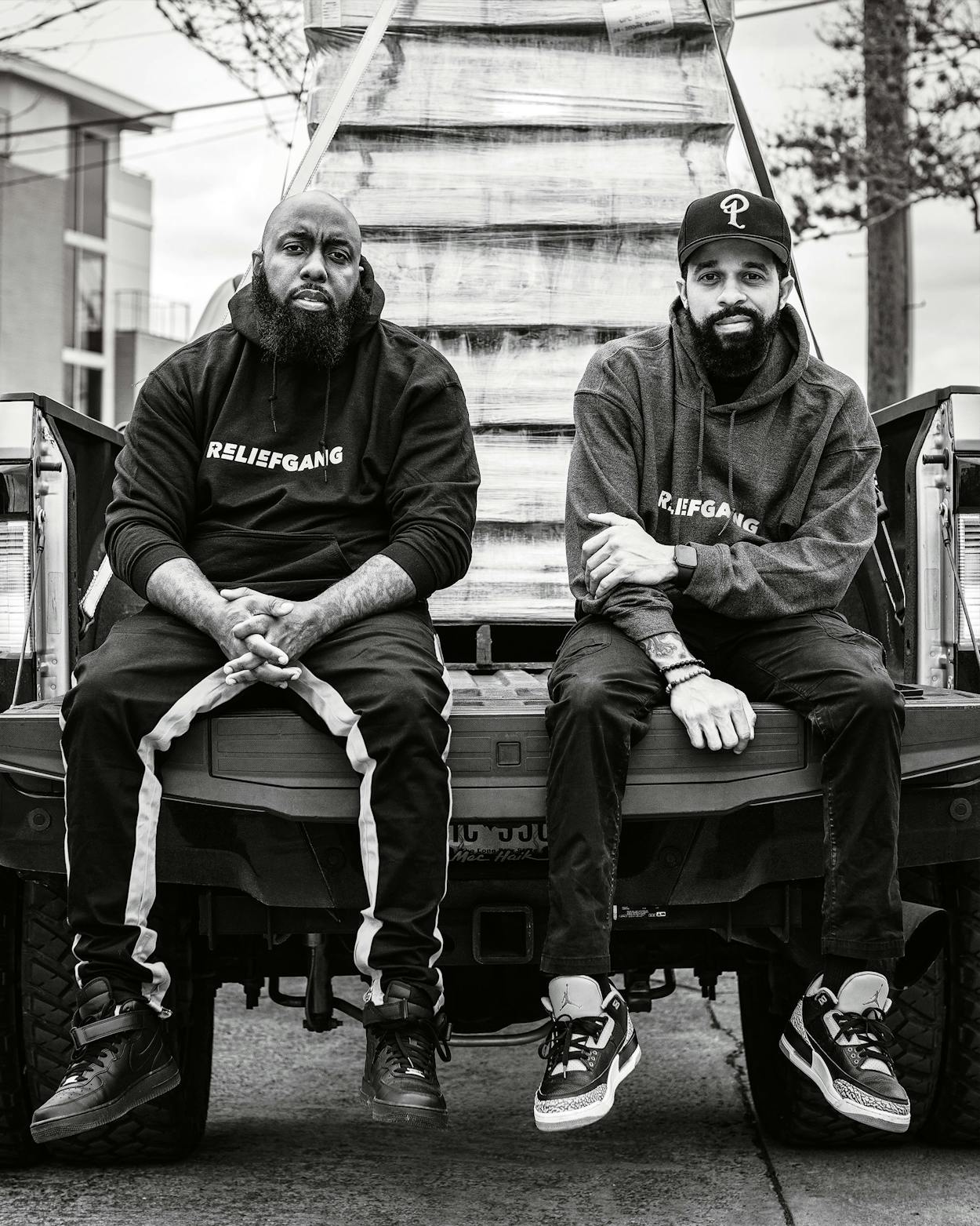No one would describe Trae tha Truth as a patient man. The Houston rapper is steady, yes, like a surgeon, with measured words delivered in a low rumble that can rattle your soft tissues. But he’s not patient. Not when he has an idea for a song, not when the phone is ringing, not when he’s driving down the highway. So in February, when temperatures sank into the single digits, the power grid went dark, water lines burst, and Texans piled on blankets while they wondered how long the contents of their refrigerators would last? Well.
Trae’s response was so predictable to his friends that it was almost parody. He pulled on a black jacket over a red hoodie, and he drove around in his gigantic yellow truck, hatching a plan. “I started buying out McDonald’s and Jack in the Box, just getting everything I could,” he said. Checking his social media for direct-messaged requests from those in need, he tossed the fast food bags into the truck and began making deliveries all over the city. As he was pulling up to homes, folks would pause from boiling the water on their stoves to look out their front windows. “Hey,” they wondered, “is that Trae tha Truth?”
Many recognized him from the nightly news, if not from around town. Trae—a nickname drawn from the suffix for Frazier Thompson III—is a burly forty-year-old with arms as big as jackhammers. His heavy eyelids often suggest weariness or concern. He is bald, with a lush, dark beard that plunges from the tops of his ears and extends an inch or two past his chin.
Along with his friend DJ Mr. Rogers, Trae captains a volunteer group called the Relief Gang, which the two formed in 2017, in the aftermath of Hurricane Harvey. Since then, the Relief Gang has become one of the most respected and relentless crews in Houston. These past four years, their mission has broadened to include all kinds of disasters.
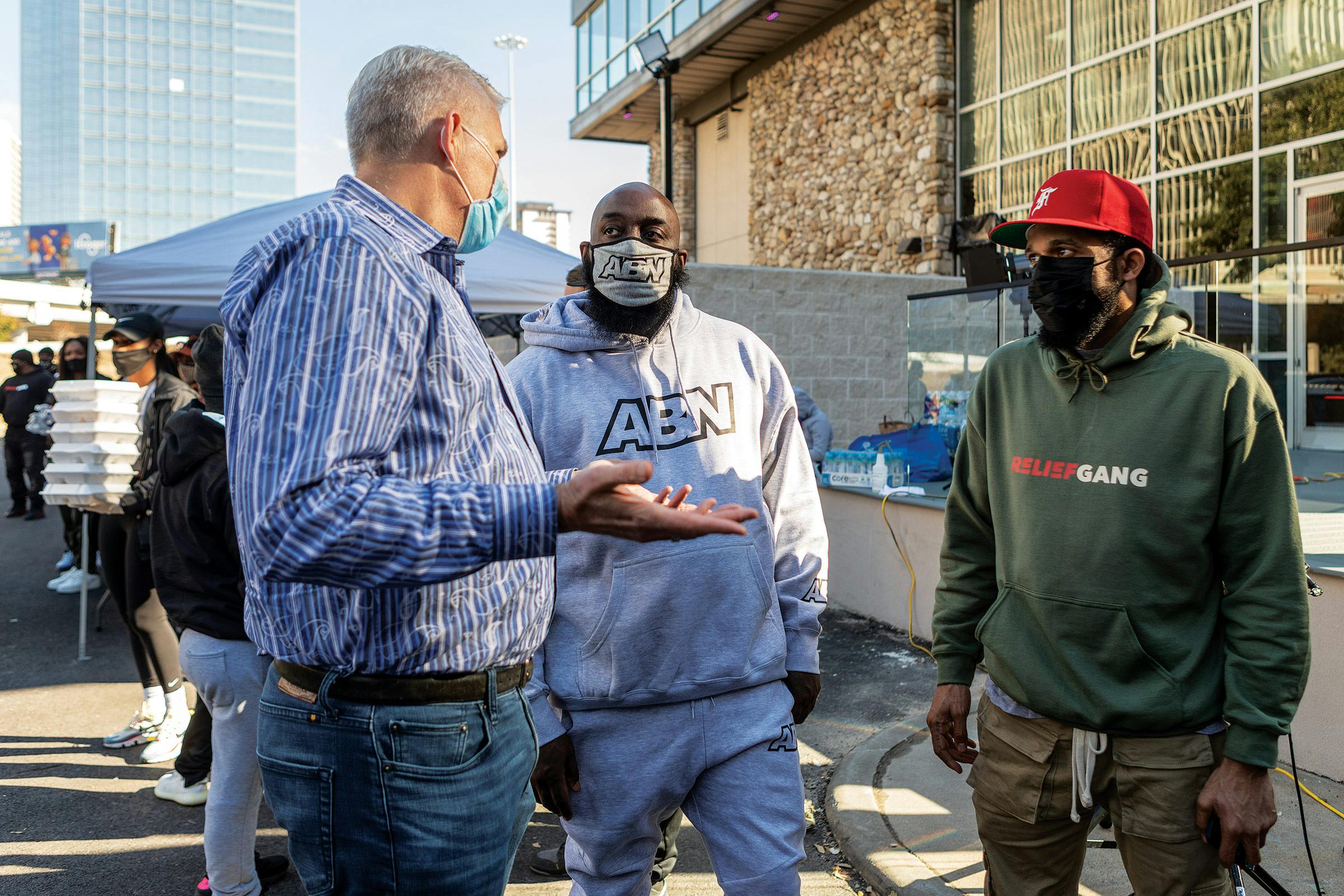
The Friday and Saturday after the winter storm, former Houston Rockets star James Harden teamed up with the Relief Gang for food and water distribution; that same Saturday, Beyoncé Knowles-Carter’s organization Beygood also joined forces with Trae to provide further aid. By late afternoon, Trae and Rogers were visiting their third location of the day, handing out meals at the Yale Village Apartments, a brick complex on the north side of town. Residents formed a line that stretched down the block as Trae coordinated with a crew of about twenty volunteers to prepare for their next stop. “Everybody go back to the warehouse. A few of us will stay here,” Trae said, assuming they would finish quickly. The line paled in comparison to the crowds they’d served earlier in the day; he said they’d already provided supplies to thousands of recipients.
As Trae passed out bags to families, the 38-year-old Rogers (whose real first name is Justin, though few call him that, even casually) leaned against a truck and explained how earlier that week, Trae had called him and they’d begun delivering power generators and space heaters. “I had, like, a thousand tea candles. And I had lighters and lanterns and stuff like that—you know, apocalypse, end-of-the-world, doomsday preparation stuff,” he said.
Even after the electricity came back on, when it would have been easier to give money to another organization and move on with their lives, the Relief Gang was still carving out flooded drywall, rounding up volunteers, and connecting plumbers with residents in need. Trae and Rogers paid for materials out of pocket when they ran low on donations.
There was only one more stop scheduled for the day, Rogers said, though volunteers knew that time was rather elastic in the Relief Gang world. The previous night, an early evening “last stop” had stretched into the morning hours.
“We’ll go back to the warehouse, and someone will call and say, ‘Hey, we’ve got three hundred more meals here!’ It’s hot food, and we can’t let it go to waste,” Rogers explained. “Today we’re at the last drop of water. But other than that, keep it going. Take it day by day.” Trae and Rogers had been planning to take some time off after Christmas last year to rest and recuperate. I reminded Trae of this as I struggled to keep up with him, holding free meals in one hand and a notepad in the other. But Trae just said he doesn’t rest. When the systems that are supposed to keep Houstonians safe break down, citizens know from experience who will show up. It’s as predictable as hurricane season.
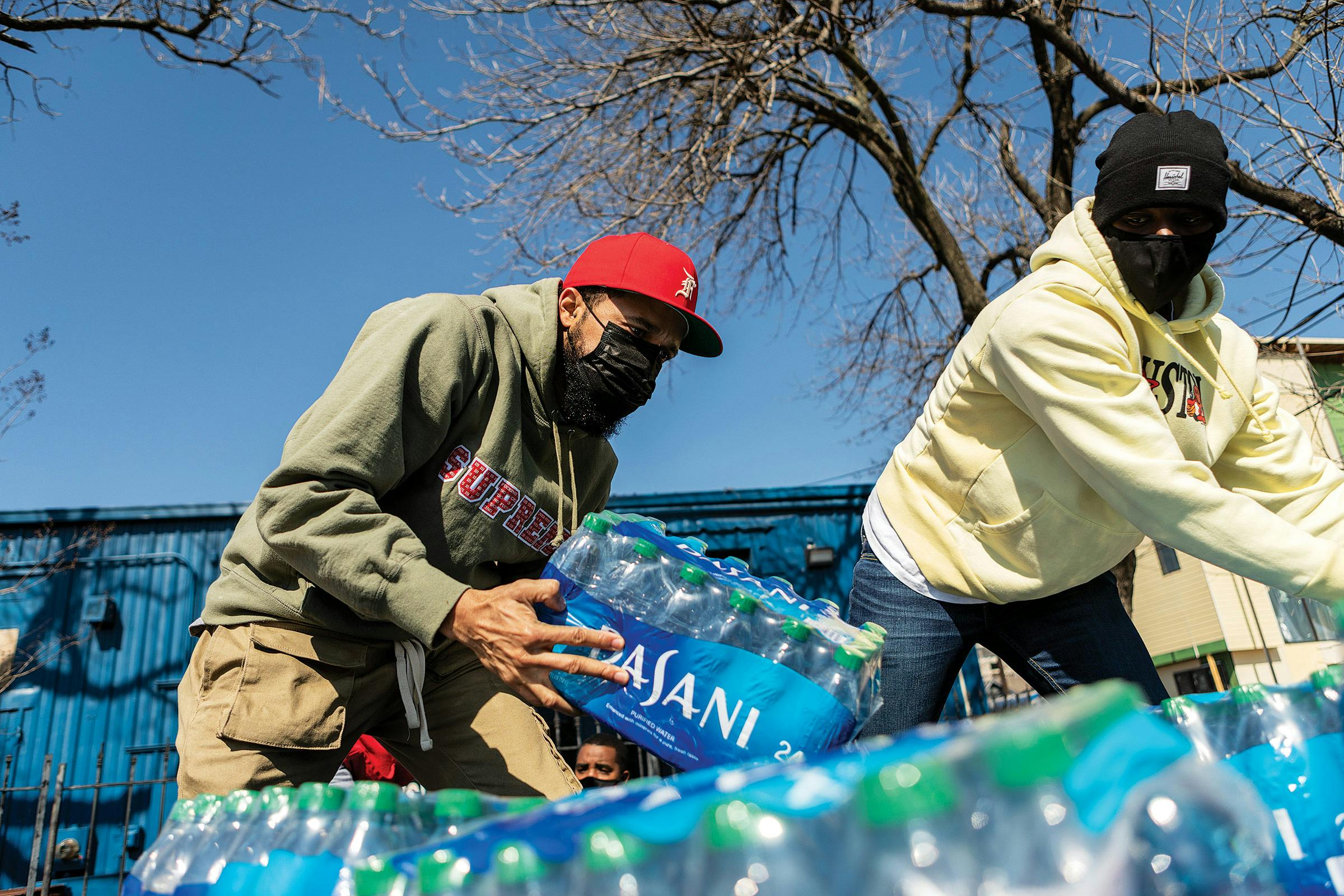
The Relief Gang was born out of frustration. During Hurricane Harvey, after being rescued himself, Trae hooked up with some friends who’d brought a boat to the National Guard checkpoint, where other rescuers were organizing and dispatching boats. “But the thing was, they were just kind of taking a while to send them out,” he said, “and our mind frame is, in the hours and time that it takes them, we can just do our own thing.” So Trae and his crew moved through neighborhoods, sometimes partnering up with other rescue groups and sometimes going solo, hopping from boats to front doors, picking up stranded residents (including, at one point, NBA star Jonathon Simmons).
“Right now, I’m by Intercontinental,” Trae told me in 2017, on the third day of his Harvey aid efforts. “Yesterday, I was in Kingwood. The day before, I was in Grand Mission, on Westpark Tollway. I was in Dickinson last night. In Galveston yesterday.” He continued, “My mother’s in Beaumont. Port Arthur and Beaumont were hit real bad, so I’m gonna be trying to find ways to get boats there ’cause I gotta get to them.”
Trae worked his way east, where he connected with DJ Mr. Rogers. A few days before, Rogers had walked out of his house in Pearland to see that the water had barely missed him. He’d posted an offer on Twitter: “Anybody displaced from the flood that’s in the Pearland area and is [in] need of a hotel room and/or food tonight hit me and I’ll take care of it.” He’d started making Costco runs to get supplies into flooded areas. Following the catastrophe in Port Arthur, where thousands of homes had been destroyed, Rogers and Trae decided to pair up: the genesis of the Relief Gang.
Since then, they and their ever-growing crew have been popping up to alleviate all manner of thorny situations. Kids in Port Arthur ISD need school uniforms? They’ll cover the costs. Someone ran out of gas while trying to stay warm in the car? They’ll fill the tank. A ninety-year-old woman is sleeping on a couch in a flood-damaged space? They’ll find her a dry place to stay while they rebuild her home. Woodridge Forest Middle School is flooding? They’ll coordinate an evacuation.


One day this past October, in the wake of Hurricane Delta, the Relief Gang headed to Lafayette, Louisiana, which had been hit hard by wind and rains, to help with cleanup. By nightfall, the crew had removed trees from nearly a dozen roofs and tacked up tarps to prevent interior water damage. The cicadas’ song grew louder, and the mosquitoes came out to investigate the smell of human sweat and test their proboscises’ strength against a preposterous amount of dust and dirt. Only one tree remained. It was an oak so thick it must have been more than a hundred years old. A forty-foot-long limb had been partly severed from the main trunk and had landed on a 1940s-style pier-and-beam home like a giant resting an arm on a table.
Everyone had taken a crack at the smaller attached limbs to break it loose—Trae, Rogers, a retired marine named David Infante—but the main branch, pinned between the trunk and the ground, wouldn’t budge. Finally, Rob Diebler, a tattooed former Army soldier who had previously worked as an arborist, climbed onto the semiattached limb and rode it like a horse as he sawed away at it. Crew members stopped in their tracks to narrate his progress and critique his technique: a few days earlier, during a Relief Gang cleanup, Diebler had accidentally cut into his leg with a chain saw. Freakishly committed, he’d returned about 45 minutes later to continue the job.
“Are you going to cut this limb you’re sitting on?” Trae said, circling him with Rogers and clearly looking for an alternative. “Because I can see why you’re nervous.”
“Hold on. This is going to fall, and I don’t want to be holding . . .” Diebler said, tossing his chain saw to the ground.
“That bitch is going to come down fast,” Trae said.
It did not, but the crew still returned to Houston before midnight, unscathed. They barely took a breath. When they’ve been out of town, Trae and Rogers often feel guilty that they’ve ignored Houston, so they make sure to host local events to compensate: a bike giveaway, a car giveaway to promote mask wearing, a school supply giveaway, a turkey dinner.
A few days earlier, Trae and Rogers had sat down on a concrete bench in Houston’s Emancipation Park, under a large, shady tree, and bidden goodbye to a traveling outdoor exhibit they’d facilitated, the Say Their Names Memorial. A handful of Relief Gang volunteers encouraged social distancing and mask wearing in a line that sometimes wrapped around the block. Winding their way through more than 36 columns, viewers surveyed photographs of more than 150 victims of race-motivated killings. From the bench, Trae and Rogers waved at a few passing toddlers, who stared at the pair as their parents walked them past; Trae bumped his chest with a fist and nodded at friends nearby.
“I HATE WHEN PEOPLE SAY, ‘THIS IS YOUR CALLING,’ ” TRAE SAID. “THIS IS MY HEART, DEFINITELY, BUT I LOVE MY MUSIC.”
Rogers had told me over the phone last summer that Trae calls him fifteen times a day. When I asked Trae if that was true, he nodded. “We get on each other’s nerves,” he said. “More so me on him.”
In the dynamic he was describing, I could more easily picture Trae irritated. He looks irritated a lot of the time—a long-standing defense, he has explained, against anyone who might try to take advantage of him. Irritation was more difficult to fathom in Rogers, who is as earnest and friendly as his cardigan-clad namesake, slender with kind eyes and a nervous energy like he’s just chugged several Red Bulls (which he probably has).
Admirers often remark that Trae and Rogers have found their true purpose in the Relief Gang. It’s meant as a compliment, but it’s one that feels backhanded to them. “I hate when people say, ‘This is your calling,’ ” Trae said. “This is my heart, definitely, but I love my music, just the way I know [Rogers] loves his music.”
Rogers, a Dallas native and Prairie View A&M University graduate, won over many Houston rappers as a producer when he was still in college. These days, he holds down a weekly show called The Neighborhood Mix on 93.7 The Beat, and he remains one of the most sought-after DJs in the city. Slim Thug, several of whose songs were produced by Rogers, said, “I don’t know a lot of DJs who have as much knowledge in music as Mr. Rogers . . . [He’s] a nerd when it comes to whatever he does. He’s gonna study it. He’s gonna know the history, especially old music. I’m a fan of him as a DJ, even if he wasn’t my friend.”
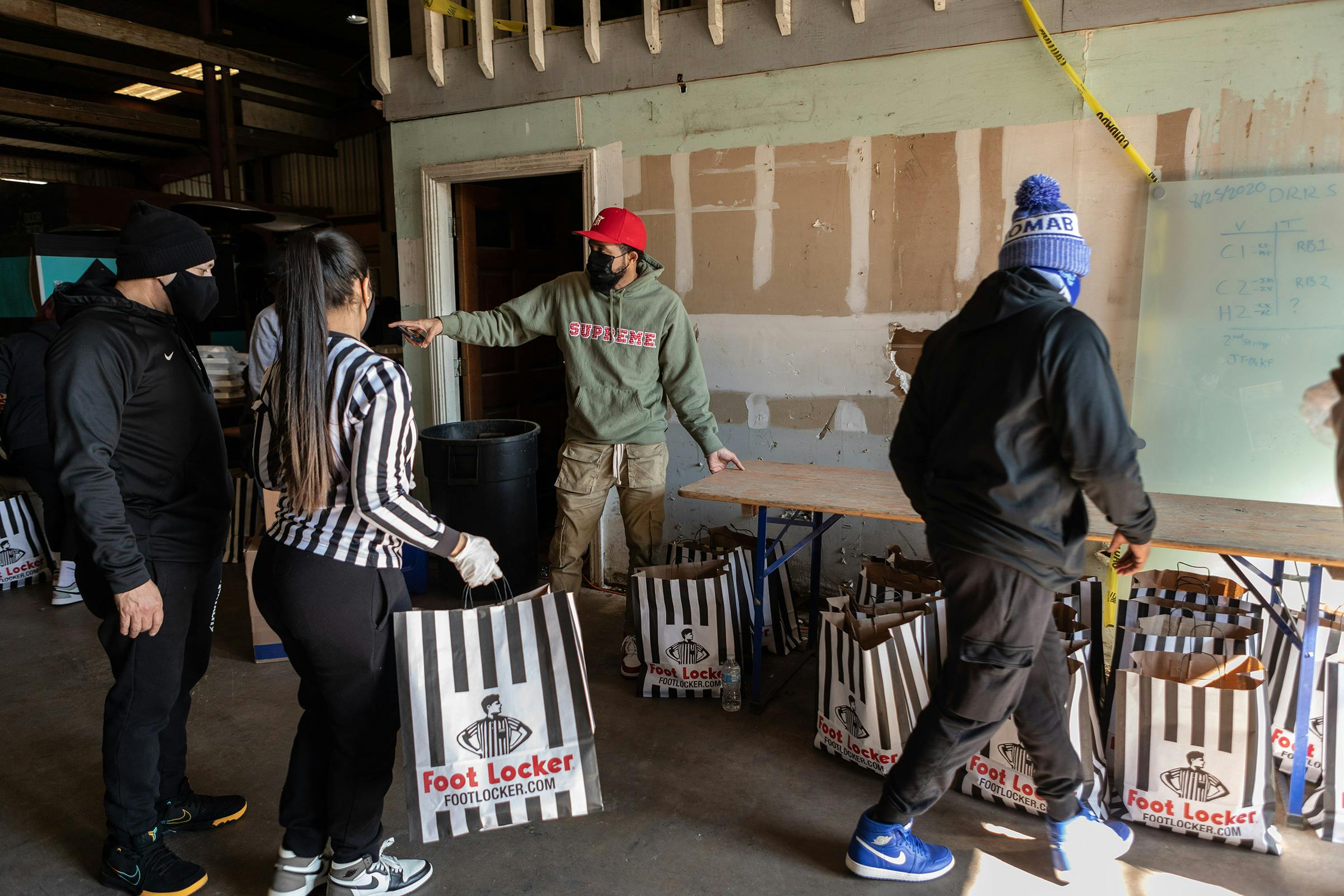
Trae’s trajectory was less straightforward. When he was twelve, his older brother Charles “Dinkie” Hughes received two life sentences, one for capital murder and one for aggravated robbery. Trae was devastated; Hughes was then, and remains, a major influence in his life. Other tragedies followed: “Two sisters murdered, another brother murdered,” he said in an interview in 2019. When he was just out of high school, Trae was convicted of aggravated robbery—though, because it was his first offense, the judge ordered a deferred sentence.
It was a turning point for Trae. “To know the shit that we doing on our regular scheduled time . . . can give us double-digit [sentences] is like, ‘Shit,’ ” Trae told interviewer DJ Vlad in 2016. “I always remained in the streets, but I just carried myself a little differently. I wouldn’t just be as reckless as I was when I was younger.”
Trae needed a release valve, a way to narrate the turmoil, and while he’d never had strong feelings about music, his brother Dinkie encouraged him to get into the burgeoning Houston rap scene, which was bringing acts like the Geto Boys and UGK to the world stage. In 1998, at just seventeen, Trae debuted on Z-Ro’s “Look What You Did to Me”; the two would join forces as the group Assholes by Nature. Soon thereafter, Trae began pursuing a solo career on the side, ultimately rapping Southern classics like “Swang” and “Cadillac.”
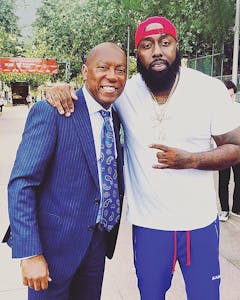
After Trae and Z-Ro parted ways, Trae continued using the ABN brand. I asked Slim Thug, who has known Trae since middle school, when he still went by Frazier Thompson, about Trae’s continued use of the ABN name—hadn’t hundreds of volunteer hours eroded that moniker? “Do not get it twisted,”he said with affection. “He’s definitely an asshole, and he knows he’s an asshole.”
In those early years, Trae used his nascent popularity as a musician to host toy drives and other philanthropic events. In 2008, the same year Trae established his nonprofit, called Angel by Nature, then-mayor Bill White honored him by designating July 22 as Trae Day. Trae used the occasion to host a party open to all, with 10,000 in attendance. He later explained to Mike Tyson, on a 2019 podcast, that he wanted to be accessible to people. “The worst feeling on earth is feeling you ain’t got nobody, it’s just you against the world, and you’re on your own.”
In 2009, the celebration for the second-annual Trae Day drew a crowd of 15,000. Celebrities like rapper Rick Ross attended, and visitors picked up free school supplies, took pony rides, and rolled up their sleeves to receive immunizations. The event was a little too successful for the fire marshal, who shut down the celebration at around 8 p.m.
The night should have ended gleefully. Instead, it ended in chaos. While guests were leaving, a handful of teens opened fire, wounding eight attendees. (Thankfully, no one died.) The next day, the morning-show host of local hiphop station 97.9 The Box insinuated that Trae was to blame for the violence, prompting rapper Bun B to call on-air in his defense. The shooters had no connection to ABN or Trae tha Truth, he said. But the station backed its host’s position. Trae, frustrated and angry, disparaged the host in a song called “Uptown”: “It’s understood when I’m rolling on glass / And the world hating on me like Nnete’s fat ass.”
LAST MAY, TRAE WAS WOKEN UP BY A PHONE CALL FROM A FRIEND. “THEY’RE SAYING FLOYD DIED,” THE FRIEND SAID.
What might have been intended as a throwaway line soon became a pivotal lyric, as the operations manager and program director banned Trae from The Box. An internal memo distributed to staff instructed, “DO NOT AIR: Trae tha Truth on our station. No interviews, no calls, no comments, no posts on our website, no station Twitter, no station Facebook, no songs in the mix show, no verses on remixes or songs in regular rotation. No exceptions. The current online postings will be removed shortly.” Trae alleged in a 2018 lawsuit against Radio One that after that, the company’s senior vice president of programming content sent out the same directive nationally. (Radio One’s attorney did not respond to multiple requests for comment.) Trae believed the ban had effectively dissolved the possibility of him booking shows or being signed to a label.
He was also crushed when some friends distanced themselves from him for fear of radio retaliation. In a 2018 radio interview he said, “Some people look at it as ‘Hey, do I stand with him, what I know is one hundred percent right, or do I feed my family?’ And I think the older I got, I just got to a point where I wasn’t angry no more. Aight, cool. If you feel you gotta feed your family, I gotta respect that.”
National artists showed solidarity by appearing on Trae’s tracks, sometimes in great numbers. For Trae’s song “I’m on 2.0,” rappers Big K.R.I.T., B.o.B., Gudda Gudda, Jadakiss, J. Cole, Kendrick Lamar, Tyga, and Bun B appeared, with a long list of high-profile cameos in the video.
At home, in Trae’s darkest hours, support came from Houston friends like DJ Mr. Rogers and a local rapper named George Floyd, who often helped Trae deliver food and supplies to charity events. Once, just before Trae accepted a humanitarian award, Floyd approached him. Floyd told Trae that one day they were going to change the world.
Last May, Trae was woken up by a phone call from a friend. “They’re saying Floyd died,” the friend said, adding that there was video of his killing. Still groggy, Trae watched the footage in shock as he tried to take in what he was seeing: his friend Big Floyd crying out for his mother as a police officer looked into a camera and slowly suffocated him. “That brought a different type of anger,” Trae said.
As the video went viral and protests mobilized across the country, Trae and Bun B marched with others through the Third Ward, past Floyd’s childhood home in the Cuney Homes projects. But the turnout felt insufficient to Trae. He and Bun B called Mayor Sylvester Turner. They told him that they wanted to host a march to show support for the Floyd family.
Turner and many of Houston’s influential rappers already had a good relationship. A few years ago, when crime in Houston was getting out of hand, Turner invited a group of about twenty rappers, including Trae, to a city hall conference room, where he asked for their help in deescalating conflicts. Though past mayors had been friendly with the city’s artists, Turner, who was inaugurated in 2016, said, “they’ve been invaluable to me . . . I grew up in the hood. I still live in the hood. It’s not like people like Trae and Bun B and DJ Mr. Rogers and Slim Thug and Paul Wall and Z-Ro haven’t been there in the past—they have. But I think there was a reluctance to call on them.”
Turner supported Trae and Bun B’s plans for a march and announced early closures of city facilities. Next, they called Chief of Police Art Acevedo, with whom the two have long had open communication. (“They’ve got my number, I’ve got their number, and we use it as needed,” Acevedo said.)
Given the short notice, Trae and Bun B expected a few thousand participants. But when they arrived at Discovery Green on June 2, two days later, 10,000 marchers had already arrived, and attendance would swell to 60,000. “For [Trae] to put that call out, spur of the moment, and get that type of response just shows that people are not dumb,” said rapper K-Rino. “The people know who’s real and who’s not.”
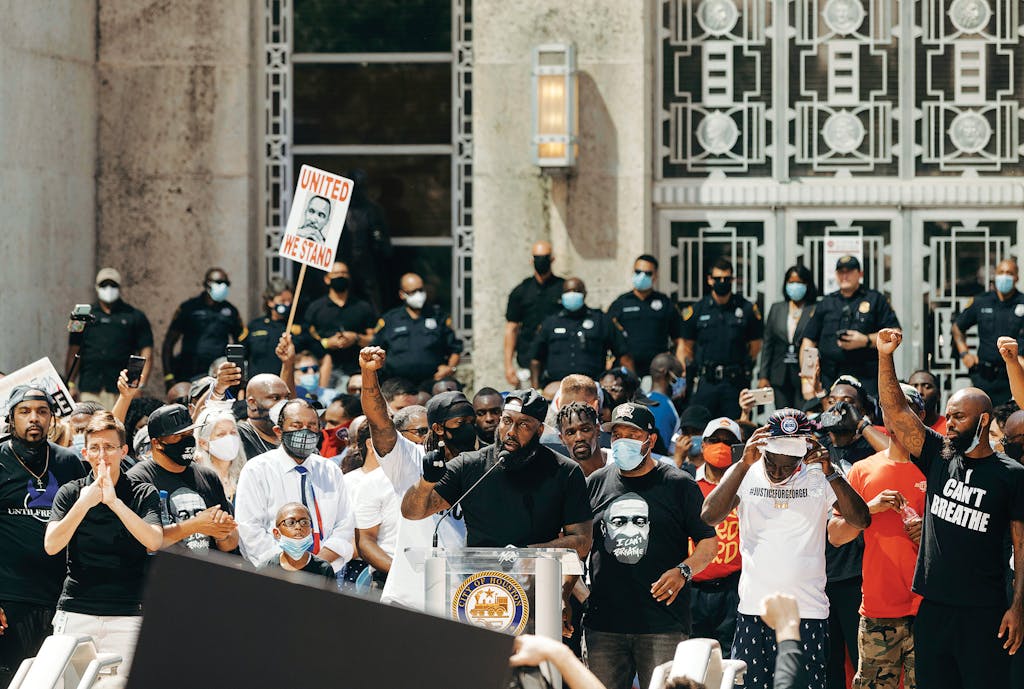
On the podium, in 90-degree heat, the Floyd family congregated with speakers, including Turner, Congresswoman Sheila Jackson Lee, civil rights attorney Lee Merritt, and longtime Houston civil rights activist Reverend Bill Lawson, 91 years old and in a wheelchair.
To kick off the speeches, Bun B took the lectern, while Trae stood to his left. “This is what representing Houston looks like,” Bun B said into the microphone. He thanked city leaders for their support before calling for more transparency from police departments, for laws that would hold racist and overzealous officers accountable, and for an independent community review board with subpoena power. “If you’re with me, say his name!” he began, in call-and-response. “George Floyd!” the crowd replied.
Then Bun B introduced Trae, “a brother of few words.” Trae leaned on the lectern as he addressed the crowd. “I want to thank every city, every state, that stood up for George Floyd that didn’t even know George Floyd,” he said. “From the city of Houston, Texas, we salute y’all a thousand percent.”
When the march began, nobody could have said how it would go. Videos of marches escalating to violence in Minneapolis and Seattle had been circulating for days. And this was a march in George Floyd’s hometown. Turner, for one, said he was nervous. If there was ever a time for levelheaded community leadership, it was now. “We had our own policing,” said Rogers, referring to protesters who arrived on horseback. “That presence says, ‘Okay, all right, it’s not gonna turn into a shit show. We’re going to control this.’ ”
“THEY ARE RELIABLE. THEY DO WHAT THEY SAY, AND THEY MEAN WHAT THEY SAY, AND THEY GET DONE WHAT THEY SAY. THAT’S A BIG, BIG DEAL.”
The march became a kind of trust test: trust between the organizers and city officials, trust between city officials and police, trust between the organizers and others marching. “I would run across large groups that were starting to assemble,” said Turner, “and you could tell it was getting very tense, especially with the police officers. I got on the phone, and I called Trae and said, ‘Trae, look: on this corner, man, there’s a large group that has assembled, and I can tell that it’s getting very tense, a lot of verbal exchanges.’ And he said, ‘Mayor, I’ve got it. My crew is on the way.’ And we exchanged those type of messages for the next couple of hours.”
In one video from the day, Trae grabs a bullhorn. “We just made history for George, man! We gave his family our word,” he says. “Let’s keep our ass moving to the park! . . . We ain’t doing no instigating, now! Let’s move!”
After the largely peaceful demonstration, Turner placed Trae on his 45-member police accountability task force, which he formed later that month to assess police policies and practices and make recommendations. Around the same time, Trae called Acevedo and reported racist social media posts from a police officer, who then retired. “He’s part of our eyes and ears,” Acevedo said of Trae.
Later in June, the Relief Gang held voter registration drives. Trae took part in out-of-state protests against police shootings—including demonstrations to honor Breonna Taylor in Kentucky. (He spent so much time in Kentucky that he rented an apartment there.)
Months after the march for George Floyd, Jackson Lee said a change was underway in community activism. Though no one could ever compare with the legacy of civil rights icons like Reverend Lawson, she said, Trae and Rogers were reenvisioning activism in their own mold. They were “creating it for the twenty-first century, building a new, iconic way, which is ‘We find a disaster, we find the people,’ ” she said. “They are reliable. They do what they say, and they mean what they say, and they get done what they say. That’s a big, big deal.”
Perhaps the Relief Gang’s work has unfairly redefined expectations for Houston rappers. “I’m just a damn rapper, and all these folks are cursing me out ’cause I’m not in the damn trenches,” Slim Thug said jokingly. “I be like, ‘I’m not no damn superhero, y’all. Trae’s got y’all thinking rappers are superheroes.’ ”
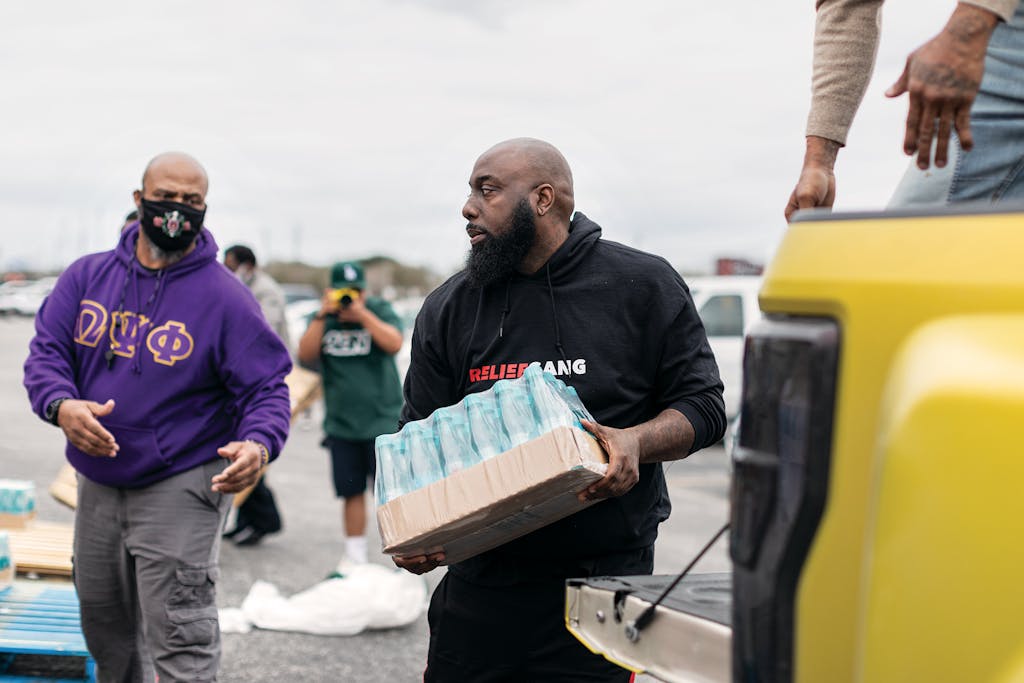
Though Trae is often skeptical—of politicians, religious leaders, and any kind of institutional gatekeepers—he is an optimist when it comes to volunteering. He believes working with the Relief Gang is on many a bucket list. Indeed, the group’s numbers have grown. The Relief Gang now includes a core crew of about twenty, including two operational coordinators who manage and vet assistance requests; a former police officer, who navigates logistics with city officials; and a few retired military officers, who keep each operation moving.
The Saturday night after the February freeze, when the Relief Gang had finished handing out meals on the north side, a few crew members drove down to the Cleme Manor Apartments, in the Fifth Ward, with a fresh supply of barbecue.
Trae asked a group of volunteers standing nearby if they would deliver some meals. A small crowd of residents had grabbed bags of food and dispersed, leaving three quiet girls heavily clad in pink. The older two looked to be about nine years old, and one of them, barefoot despite 50-degree temperatures, carried on her back a younger girl wearing a hoodie that broadcasted her love of unicorns.
“I need meals for them,” Trae told a nearby volunteer. “Three.” He asked if they wanted any water, and someone else jumped in to help the girls carry a case of water that had materialized. Then Trae quickly moved the volunteers and their insulated bags of food through the darkened complex, knocking on doors. “Hey, we got food for y’all!” he shouted as he hustled down the sidewalk. “Water too!”
Trae wouldn’t check his phone till he got back to his truck. The requests filling his and Rogers’s inboxes were evidence of one day’s endless need. But they were also testaments to how the Relief Gang is rewriting old scripts—the ones that say you’ve got nobody and you’re on your own.
“I think what is unique about Trae tha Truth is he doesn’t make appointments. He doesn’t wait for someone else to ask him,” said Jackson Lee. “He’s just right there. He has a sixth sense on people in need, and he is right there.”
This article originally appeared in the April issue of Texas Monthly with the headline “You’re Never on Your Own in Houston.” Subscribe today.
- More About:
- Music
- Winter Storm 2021
- Longreads
- Hurricane Harvey
- George Floyd
- Houston
